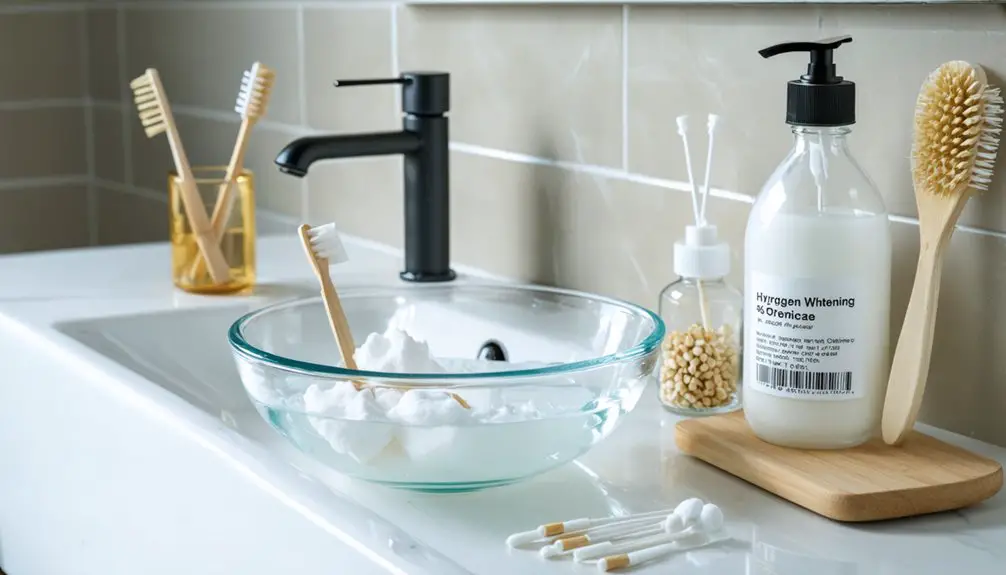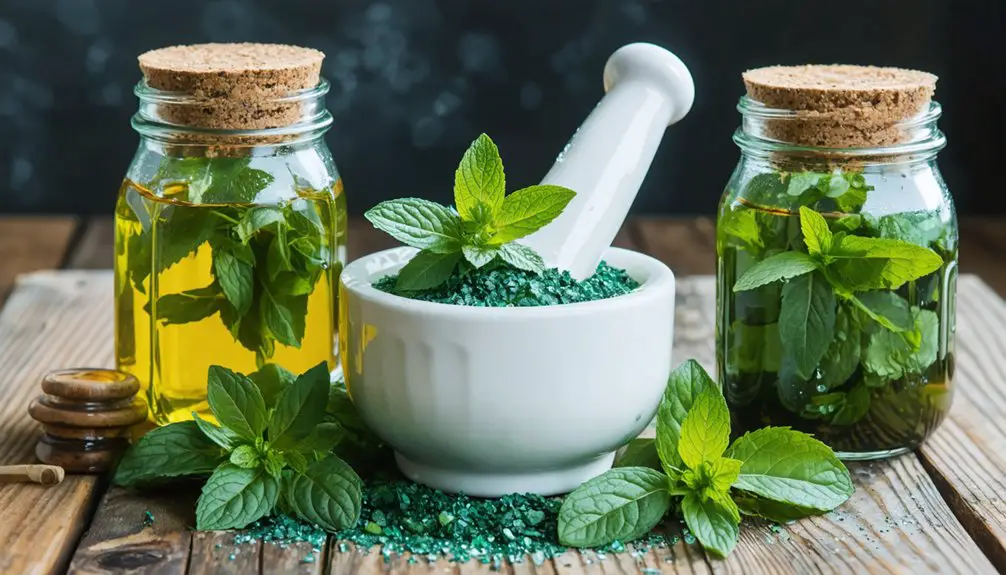You can naturally whiten your teeth using five safe ingredients found in your kitchen. Tropical fruits like pineapple and papaya contain enzymes that break down stains, while activated charcoal binds to surface discoloration. Baking soda offers gentle abrasion for removing coffee and wine stains. Banana peels provide minerals for enamel health, and strawberries contain natural acids that brighten teeth. Discover how to properly use these ingredients for ideal results and minimal sensitivity.
Key Takeaways
- Baking soda creates a gentle whitening paste that effectively removes stains from coffee, tea, and wine within 1-2 weeks.
- Pineapple’s bromelain and papaya’s papain enzymes naturally break down protein stains while promoting healthier gums.
- Activated charcoal binds to surface stains through gentle abrasion, but should be used cautiously to protect tooth enamel.
- Strawberries contain natural malic acid for whitening benefits, but limit use to once weekly to prevent enamel damage.
- Banana peels provide minerals for enamel health, requiring just two minutes of gentle rubbing followed by 10-15 minutes contact time.
Natural Enzymes From Tropical Fruits
When it comes to natural tooth whitening, tropical fruits contain powerful enzymes that can effectively brighten your smile. Pineapple’s bromelain and papaya’s papain break down the protein-rich pellicle layer where stains accumulate on your teeth. These proteolytic enzymes work synergistically with your saliva to enhance natural cleansing and stain removal. Malic acid in strawberries offers another natural whitening option when paired with tropical fruits.
The tropical fruit benefits extend beyond whitening. Their enzyme synergy creates a multi-faceted approach to oral care. Bromelain’s anti-inflammatory properties soothe gum tissue, while papain disrupts bacterial biofilms that cause plaque. Vitamin C from oranges provides additional immune support for optimal gum health.
You’ll also stimulate increased saliva production, which helps neutralize acids and wash away stain-causing particles. By incorporating these fruits into your diet, you’re choosing a gentle, natural alternative to harsh chemical whiteners while supporting overall oral health.
The Power of Activated Charcoal
Activated charcoal’s microscopic structure makes it a powerful tool for natural tooth whitening. When you use charcoal-based toothpaste, its highly porous particles bind to surface stains and help remove them through gentle abrasion.
While activated charcoal benefits include stain removal, you’ll find its effects are primarily limited to external discoloration. Social media trends have significantly boosted the popularity of charcoal-based whitening products. The recommended 3-5 minute brushing time is needed to achieve optimal stain removal results.
Activated charcoal can effectively remove surface stains from teeth, but don’t expect it to address deeper, internal discoloration issues.
Consider charcoal safety before incorporating it into your oral care routine. Frequent use can potentially wear down tooth enamel, especially if the product lacks fluoride for remineralization.
You’ll want to verify that your chosen charcoal toothpaste contains additional protective ingredients like silica and fluoride. For best results, use it as part of a balanced approach to whitening, rather than relying on it exclusively.
Monitor for any sensitivity and discontinue use if you experience discomfort.
Baking Soda: A Gentle Whitening Champion
Among natural tooth whitening options, baking soda stands out as a gentle yet effective champion for removing surface stains. Its dual-action whitening effectiveness combines mild abrasion with acid-neutralizing properties, making it particularly effective against coffee, tea, and wine discoloration. Twice-daily brushing helps maintain optimal results and enamel health. For best application, simply wet your toothbrush before dipping it into baking soda.
You’ll notice visible results within 1-2 weeks of consistent use, especially when mixing equal parts baking soda and water into a paste.
- You’re protecting your loved ones’ smiles with a safe, chemical-free alternative
- You’re providing affordable dental care solutions to those who need it most
- You’re offering a trusted, time-tested remedy that generations have relied upon
- You’re empowering others with knowledge of natural oral care options
- You’re sharing baking soda benefits that extend beyond just whitening to overall oral health
Banana Peels’ Hidden Whitening Properties
Despite limited scientific validation, banana peels have emerged as an intriguing natural alternative for teeth whitening due to their rich mineral composition. The peels contain potassium, magnesium, and manganese, which may promote enamel re-mineralization and reduce oral bacteria. Current research shows no conclusive evidence exists supporting this method’s effectiveness.
To maximize banana peel benefits, brush and floss first, then rub the inside of a ripe yellow peel against your teeth for two minutes. Allow the residue to remain for 10-15 minutes before rinsing. Avoid eating or drinking for 30 minutes afterward.
While mineral absorption into tooth enamel remains unproven, this gentle method poses minimal risks and may offer complementary dental health benefits. Remember that results vary considerably and develop gradually.
For best outcomes, consider this natural approach as part of your overall oral care routine rather than a replacement for professional whitening treatments.
Safe Application of Strawberry-Based Solutions
While strawberries’ natural whitening properties have garnered attention, their safe application requires careful consideration to prevent enamel damage.
When using strawberry-based solutions for teeth whitening, you’ll need to prioritize enamel protection through controlled application methods and frequency. Studies show that mixing strawberries with baking soda produces no whitening benefits.
Research shows that while strawberries contain malic acid for surface stain removal, their acidic nature can potentially harm your dental health if not used properly.
Despite their natural whitening abilities, strawberries’ acidic content requires careful use to avoid compromising your dental health.
Professional dental treatments using hydrogen peroxide compounds deliver more reliable whitening results than strawberry-based methods.
- Never leave strawberry paste on your teeth longer than 2 minutes to protect your enamel
- Limit applications to once weekly to minimize erosion risks
- Rinse thoroughly after each use to neutralize acidic effects
- Avoid combining strawberries with abrasive substances like baking soda
- Consult your dentist before starting any strawberry-based whitening routine, especially if you have sensitive teeth
Frequently Asked Questions
How Long Should I Wait Between Different Natural Whitening Treatments?
You’ll need to wait 3-7 days between natural whitening treatments, following best practices. Don’t exceed two treatments per week, and maintain consistent treatment intervals to protect your enamel’s health.
Can These Natural Ingredients Remove Deep-Set Stains From Smoking?
Natural remedies can help lighten surface stains, but you’ll need professional treatment for deep-set smoking stains. While ingredients like hydrogen peroxide aid stain removal, they can’t fully eliminate long-term discoloration.
Will Natural Whitening Methods Work on Teeth With Existing Dental Work?
Ever wondered why your dental work stays the same color? Natural whitening won’t affect crowns, implants, or veneers since they’re made of non-porous materials. You’ll only see changes in your natural teeth.
How Often Should Teeth Be Whitened to Maintain Results?
You’ll need professional whitening every 6-12 months, with at-home touch-ups every 3-6 months. Follow your dentist’s recommended whitening frequency and use daily maintenance tips to extend results between treatments.
Are Natural Whitening Ingredients Safe During Pregnancy?
While you’d think all natural means safe, consult your doctor first. During pregnancy, stick to gentle alternatives like baking soda brushing and nano hydroxyapatite toothpaste for safer whitening benefits.
References
- https://jamdsr.com/uploadfiles/25vol10issue1pp109-114.20220128072249.pdf
- https://www.todaysrdh.com/study-shows-natural-tooth-whiteners-as-effective-as-peroxide-whiteners/
- https://pmc.ncbi.nlm.nih.gov/articles/PMC10024105/
- https://pmc.ncbi.nlm.nih.gov/articles/PMC4058574/
- https://www.ada.org/resources/ada-library/oral-health-topics/whitening
- https://www.hollywoodwhitening.com/en/blog/top-foods-that-will-whiten-your-teeth/
- https://www.parbolddental.co.uk/blog/tooth-whitening-and-dietary-choices-8-foods-that-brighten-your-smile-naturally/
- https://www.healthline.com/health/foods-that-whiten-teeth
- https://www.instagram.com/p/C1EuRDQMkPC/
- https://lifamilydental.ca/10-foods-helping-to-whiten-your-teeth



